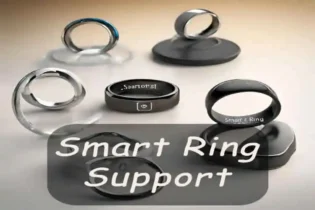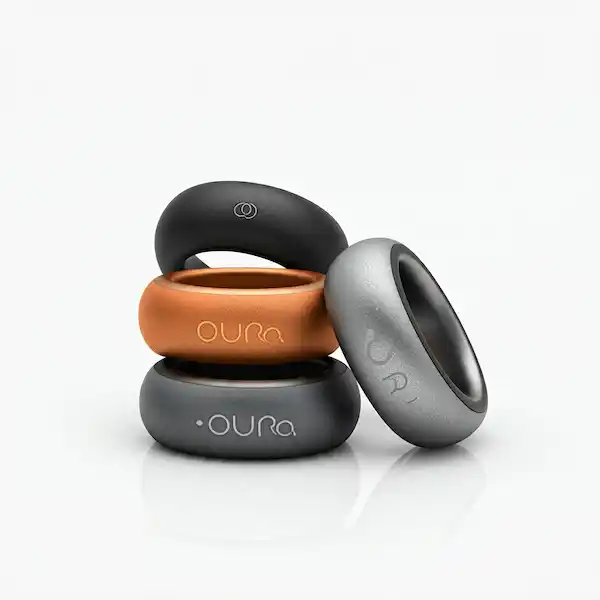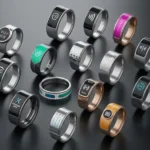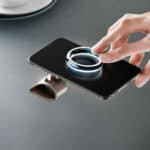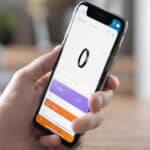Unlocking Your Well-being: A Comprehensive Guide to Smart Rings
The world of wearable technology is constantly evolving, and at its forefront are smart rings – discreet, powerful devices that blend seamlessly into your daily life. No longer just a futuristic concept, these tiny titans are packing a punch when it comes to health tracking, convenience, and connectivity. Whether you’re an iPhone enthusiast or an Android loyalist, a smart ring can offer a unique and often more comfortable alternative to smartwatches or fitness bands. Continue reading to learn more about what is a smart ring, what can a smart ring do, and how does a smart ring work?
What is a Smart Ring?
A smart ring is a compact, finger-worn electronic device that integrates advanced sensors and mobile technology into a traditional ring form factor. Unlike bulky smartwatches, smart rings are designed for discreet, continuous wear, making them ideal for long-term health monitoring and unobtrusive interaction. They are typically made from durable materials like titanium or aluminum and come in various styles to suit individual preferences.
What Can a Smart Ring Do?
What is a smart ring and what can it do? Despite their small size, smart rings are incredibly versatile, offering a wide array of functionalities. Their capabilities generally fall into these key areas:
- Health and Wellness Monitoring: This is often the primary draw of smart rings. They can track:
- Heart Rate and Heart Rate Variability (HRV): Continuous monitoring of your heart rate and HRV provides insights into your cardiovascular health, stress levels, and recovery.
- Sleep Tracking: Advanced sensors can accurately detect sleep stages (light, deep, REM), sleep duration, disturbances, and even blood oxygen saturation (SpO2) during sleep, offering a comprehensive picture of your sleep quality.
- Activity Tracking: Like fitness trackers, smart rings can count steps, estimate distance traveled, calculate calories burned, and even detect specific workouts.
- Skin Temperature: Monitoring skin temperature trends can help detect early signs of illness or track menstrual cycles.
- Blood Oxygen (SpO2) Monitoring: Measures the oxygen saturation in your blood, which can be an indicator of respiratory health.
- Stress Levels: By analyzing various biometric data, some rings can estimate and track your stress levels.
- Advanced Metrics (on select rings): Some cutting-edge smart rings are emerging with capabilities like continuous glucose monitoring and blood pressure readings.
- Notifications: Receive subtle vibrations on your finger for incoming calls, messages, and app alerts from your connected smartphone, allowing you to stay informed without constantly checking your phone.
- Gesture Controls: Some smart rings incorporate gesture recognition, enabling you to control music playback, take photos, dismiss alarms, or even control smart home devices with simple hand movements.
- Contactless Payments: With built-in NFC (Near Field Communication) technology, certain smart rings allow you to make secure payments with a tap of your finger, eliminating the need to carry your wallet or phone.
- Access Control and Information Sharing: NFC capabilities can also extend to unlocking smart doors, starting compatible cars, or sharing contact information with a simple tap.
How Does a Smart Ring Work?
What is a smart ring and how does it work? Smart rings utilize a combination of sophisticated sensors and wireless communication protocols to gather data and interact with your devices:
- Sensors:
- Optical Bio-signal Sensors (PPG): These sensors shine light (often green or infrared) onto your skin and measure the light reflected back. Changes in light absorption are used to detect blood flow, which in turn calculates heart rate, heart rate variability, and blood oxygen levels. Fingers often provide more accurate readings for PPG than wrists due to a richer network of blood vessels closer to the skin.
- Accelerometers: These detect motion and are used to track steps, activity levels, and sleep movements.
- Skin Temperature Sensors: Measure your body’s temperature, particularly useful for sleep tracking and detecting deviations from your baseline.
- Connectivity (Bluetooth Low Energy – BLE): Smart rings primarily connect to your smartphone via Bluetooth Low Energy (BLE). This efficient wireless technology allows for continuous data syncing without rapidly draining the ring’s or phone’s battery.
- Companion Apps: All data collected by the smart ring is transmitted to a dedicated companion app on your smartphone (available for both iPhone and Android). This app serves as your central hub for:
- Viewing detailed health metrics and trends.
- Customizing ring settings and preferences.
- Receiving personalized insights and recommendations.
- Updating firmware.
- Power: Smart rings house tiny, long-lasting batteries. Depending on the model and usage, they can often last for several days on a single charge, typically recharged wirelessly using a small charging case or dock.
iPhone vs. Android Compatibility
What is a smart ring and which smartphones is it compatible with? The good news is that most leading smart ring brands offer compatibility with both iPhone (iOS) and Android devices. However, there can be nuances:
- Broad Compatibility: Brands like Oura, Ultrahuman, and RingConn are designed to work seamlessly with both iOS and Android. Their companion apps are available on both the Apple App Store and Google Play Store.
- Samsung Galaxy Ring: While it generally works with most Android devices, its most advanced features, such as snore tracking and AI health assessments, are often optimized for or exclusive to Samsung Galaxy phones.
- App Integrations: While the core functionalities are consistent, the specific third-party app integrations might vary slightly between iOS and Android due to differences in platform ecosystems (e.g., Apple Health integration on iOS).
It’s always crucial to check the manufacturer’s specifications for full compatibility details before purchasing a smart ring.
Best Use Cases for Smart Rings
Smart rings excel in scenarios where discreet, continuous, and comfortable tracking is paramount:
- Holistic Health and Wellness Enthusiasts: For individuals focused on understanding their body’s overall well-being, including sleep quality, recovery, and stress management, without the constant visual distraction of a screen.
- Sleep Optimization: Their comfortable and lightweight design makes them superior for overnight wear compared to bulkier smartwatches, leading to more consistent and accurate sleep data.
- Discreet Notifications: Receive important alerts without pulling out your phone, ideal for meetings, social gatherings, or situations where checking a phone might be inappropriate.
- Fitness Tracking (Passive): While not as feature-rich as dedicated GPS-enabled sports watches for intense workouts, smart rings are excellent for passive activity tracking, steps, and general movement.
- Contactless Payments and Access: Enjoy the convenience of making payments or unlocking doors with just a tap of your finger, enhancing everyday efficiency.
- Minimalists: For those who prefer a clean aesthetic and minimal tech on their wrist, a smart ring offers powerful functionality in an elegant form.
Built-in Apps and Third-Party App Integrations
The “apps” associated with smart rings primarily refer to their dedicated companion applications on your smartphone and their ability to integrate with other health and fitness platforms.
Built-in/Companion Apps:
Each smart ring typically comes with its own proprietary app. These apps are crucial for:
- Data Visualization: Presenting your health metrics (heart rate, sleep stages, activity) in easy-to-understand graphs and dashboards.
- Personalized Insights: Providing scores (e.g., “Readiness Score,” “Sleep Score,” “Energy Score”), trends, and actionable recommendations based on your data.
- Goal Setting: Allowing you to set and track personal health and fitness goals.
- Settings and Customization: Managing notification preferences, sensor settings, and firmware updates.
- Historical Data: Storing and allowing you to review your long-term health trends.
Examples include the Oura App, Samsung Health (for Galaxy Ring), Ultrahuman App, and RingConn App.
Third-Party App Integrations:
A significant advantage of many smart rings is their ability to sync data with popular third-party health and fitness applications. This allows you to consolidate your health data from various sources into a single platform. Common integrations include:
- Apple Health (iOS): Seamlessly integrates health data from your smart ring into Apple’s comprehensive health ecosystem.
- Google Fit (Android): Connects your smart ring data with Google’s health and fitness platform.
- Fitness Apps (e.g., Strava): While rings don’t have GPS, some can sync activity data for a more complete picture of your fitness.
- Wellness Apps (e.g., Natural Cycles, Clue, Headspace, Noom, Zero): Integrate sleep, temperature, and other biometrics for deeper insights into reproductive health, mindfulness, and nutrition.
- Research Platforms: Some rings may offer data sharing for research purposes, contributing to broader scientific understanding of wearable health tech.
Example of an App Interface (Conceptual):
Imagine a smart ring app with a clean, intuitive interface:
- Home Dashboard: Displays your daily “Readiness Score,” last night’s “Sleep Score,” and current heart rate.
- Sleep Tab: Detailed breakdown of sleep stages, duration, and efficiency, with personalized tips for improvement.
- Activity Tab: Shows steps, distance, calories, and active time, with trends over the week.
- Trends Tab: Long-term graphs of HRV, resting heart rate, and temperature, highlighting patterns and changes.
- Insights Tab: AI-powered recommendations based on your unique data, such as “prioritize sleep tonight” or “consider a short walk to reduce stress.”
Comparison Chart: Leading Smart Rings (iPhone & Android)
Here’s a comparison of some popular smart rings, highlighting their key features and compatibility:
| Feature/Ring | Oura Ring Gen 3/4 | Samsung Galaxy Ring | Ultrahuman Ring Air | RingConn Smart Ring |
| Best For | Overall wellness, accurate sleep & readiness | Samsung users, battery life, AI wellness | Fitness, activity focus, lightweight | Budget-conscious, detailed sleep apnea detection |
| Compatibility | iOS & Android | Android (best with Samsung) | iOS & Android | iOS & Android |
| Key Health Metrics | HR, HRV, SpO2, sleep stages, temp, activity | HR, SpO2, sleep stages, temp, activity, snore tracking (Samsung only) | HR, HRV, SpO2, sleep, activity, recovery, caffeine | HR, SpO2, sleep (incl. apnea), temp, activity, stress |
| Unique Features | “Readiness Score”, “Sleep Score”, period prediction | AI wellness insights, energy score, gesture controls | Focus on recovery, “Caffeine Insights” | No subscription fee, continuous SpO2 |
| Battery Life | Up to 7-8 days | Up to 7 days | Up to 6 days | Up to 10 days |
| Subscription Req. | Yes (for most features) | TBD (likely not for core, but premium features possible) | No (some “PowerPlugs” extra) | No |
| Materials | Titanium | Titanium | Lightweight alloy | Medical-grade stainless steel |
| Water Resistance | Swim-proof (check specific depth) | Swim-proof (check specific depth) | Swim-proof (check specific depth) | Swim-proof (check specific depth) |
| App Integrations | Extensive (Apple Health, Strava, Natural Cycles, etc.) | Samsung Health, potentially others | Apple Health, Google Fit | Apple Health, Google Fit |
Disclaimer: Features and prices are subject to change. Always verify the latest specifications from the manufacturer.
Is a Smart Ring Right for You? The Honest Truth
Before you commit to wearing a piece of tech on your finger 24/7, it’s worth weighing whether it actually fits your lifestyle. I’ve gone through phases where I loved my smart ring and phases where I missed my traditional watch.
The biggest “pro” for me was the discretion. I wore my ring to a wedding last summer, and I loved that I was tracking my heart rate and steps without a glowing screen buzzing on my wrist during the ceremony. It felt elegant. On the flip side, the “con” hit me when I went to the gym. Lifting heavy barbells with a metal ring on is not only uncomfortable—it can actually be dangerous (Google “ring avulsion” if you have a strong stomach) and it’ll scratch the finish of your ring in seconds.
To help you decide, I’ve broken down the pros and cons based on my experience and the general consensus among the “ring-tech” community.
Smart Ring Pros vs. Cons
| Feature | The Pros (Why You’ll Love It) | The Cons (The Potential Dealbreakers) |
| Form Factor | Ultra-discreet and lightweight. Most people won’t even realize you’re wearing a fitness tracker. | Easy to lose. If you take it off to wash your hands or at the gym, it’s much easier to misplace than a watch. |
| Sleep Tracking | Superior comfort. It is significantly easier to sleep with a ring than a bulky smartwatch. | No “Smart” Alarms. Most rings lack a vibration motor, so they can’t wake you up silently like a watch can. |
| Battery Life | Long-lasting. Most rings last 4–7 days on a single charge since they don’t have a screen to power. | Proprietary chargers. If you lose the tiny charging cradle, the ring is useless until you buy a specific replacement. |
| Distraction Level | Zero screen time. No notifications or apps means you stay present in the moment. | No real-time data. You have to open your phone to see your stats; you can’t just glance at your finger to see the time or your pace. |
| Durability | Waterproof. Almost all are safe for swimming and showering. | Prone to scratches. Daily tasks like gripping a steering wheel or holding a coffee mug can scuff the outer finish over time. |
My Verdict
If you are someone who values sleep data and aesthetic minimalism, a smart ring is a no-brainer. It provides some of the most accurate sleep stages because the skin on the base of your finger is thinner than your wrist, allowing the sensors to get a better “read” on your pulse.
However, if you are a hardcore athlete who needs to see your heart rate in real-time while running, or if you rely on your wrist to see incoming text messages, you might find the “screenless” experience a bit limiting. Personally, I use both: a ring for sleep and daily wellness, and a GPS watch only when I’m out for a run.
Additional Helpful Content:
- Choosing the Right Size: Smart rings need to fit snugly for accurate sensor readings. Most brands offer sizing kits before purchase. Wear the ring on the finger you intend to use it on for a few days to ensure comfort and accurate data.
- Comfort and Style: Unlike smartwatches, smart rings are designed to be worn continuously. Consider the material, weight, and aesthetic that best suits your lifestyle.
- Data Privacy: Reputable smart ring manufacturers employ encryption and adhere to data privacy regulations. Always review a company’s privacy policy to understand how your health data is handled.
- Battery Life Expectations: While generally long, battery life can vary with usage, especially with constant data syncing or frequent notification alerts.
- Subscription Models: Be aware that some smart rings require a monthly or annual subscription to access all features and insights. Factor this into your overall cost.
Troubleshooting Common Problems
Even the most advanced tech can encounter glitches. Here are some common smart ring problems and their potential solutions:
- Ring Not Connecting to App/Phone:
- Check Bluetooth: Ensure Bluetooth is enabled on your phone.
- Restart Ring & Phone: A simple reboot can often resolve connectivity issues.
- Re-pair Device: In the app settings, try unpairing and then re-pairing the ring.
- Update App & Firmware: Ensure both your smart ring app and the ring’s firmware are up to date.
- Battery Level: A low battery can prevent connection. Charge your ring fully.
- Proximity: Keep your ring close to your phone during pairing.
- Inaccurate or Missing Data (Heart Rate, Sleep, etc.):
- Ring Fit: This is the most common cause. The ring must be snug but comfortable, with the sensors making good contact with your skin. If too loose or too tight, readings will be off. Try different fingers or sizes if needed.
- Ring Orientation: Ensure the ring is oriented correctly as per the manufacturer’s instructions (e.g., sensors on the palm side).
- Clean Sensors: Dust or debris on the sensors can interfere with readings. Wipe them gently with a dry cloth.
- Temperature: Cold hands can restrict blood flow and affect PPG sensor accuracy.
- Movement Artifacts: Excessive or rapid movements during activity can sometimes disrupt readings.
- Software Glitch: Restarting the app or the ring might help.
- Battery Draining Quickly:
- Frequent Syncing: If the ring is constantly trying to sync or encountering connection issues, it can drain faster.
- Notifications: High volume of notifications can impact battery life. Adjust notification settings in the app.
- Feature Usage: Certain features (e.g., continuous SpO2 monitoring) might consume more power.
- Battery Age: Like all batteries, a smart ring’s battery capacity will naturally degrade over time.
- Charger Issues: Ensure the charging contacts on both the ring and charger are clean and that the charger is properly connected to a power source.
- Charging Problems:
- Proper Alignment: Ensure the ring is correctly aligned on its charging dock or case.
- Clean Contacts: Wipe charging contacts on both the ring and charger to remove any debris.
- Power Source: Try a different USB port or power adapter.
- Charging Case Battery: If using a charging case, ensure the case itself is charged.
Smart rings are quickly becoming an indispensable tool for those looking to seamlessly integrate health monitoring and digital convenience into their lives. By understanding their capabilities, how they work, and choosing the right one for your needs, you can unlock a new level of personal well-being and connectivity.
Frequently Asked Questions (FAQ)
Q1: Is a smart ring a medical device? A1: No, generally smart rings are consumer wellness devices and are not intended for medical diagnosis, treatment, or prevention of any disease. While they provide valuable health insights, they should not replace professional medical advice.
Q2: How accurate are smart rings for health tracking? A2: Modern smart rings, especially reputable brands, offer high accuracy for metrics like heart rate and sleep staging, often validated through peer-reviewed studies. However, accuracy can be affected by fit, movement, and individual physiology. They are best for spotting trends and patterns rather than precise medical-grade measurements.
Q3: Can I wear my smart ring in the shower or while swimming? A3: Most smart rings are water-resistant, allowing for daily activities like hand washing and showering. Many are also swim-proof. Always check the specific water resistance rating (ATM or depth) from the manufacturer before submerging your ring for extended periods or in extreme conditions (e.g., deep diving, hot tubs, saunas, ice baths, which can impact battery longevity).
Q4: Do smart rings require a subscription? A4: Some popular smart rings, like the Oura Ring, require a monthly subscription to access all advanced features, historical data, and personalized insights. Other brands, like RingConn, offer their full features without a recurring fee.
Q5: Which finger should I wear my smart ring on? A5: Most manufacturers recommend wearing the smart ring on your index, middle, or ring finger for optimal sensor contact. The most important factor is finding a finger where the ring fits snugly but comfortably.
Q6: How often do I need to charge a smart ring? A6: Battery life varies by model and usage, but most smart rings offer several days (typically 4-10 days) of battery life on a single charge. Charging usually takes between 20-80 minutes.
Q7: Can a smart ring replace a smartwatch? A7: It depends on your needs. Smart rings excel at discreet, continuous health tracking and subtle notifications. Smartwatches offer a more interactive screen, robust workout tracking with GPS, and more direct communication features (like answering calls on the watch). They serve different purposes, though there is some overlap.
Q8: Are smart rings safe to wear? A8: Yes, smart rings are generally safe to wear. They emit very low levels of electromagnetic radiation (similar to Bluetooth headphones). They are designed for continuous skin contact and made from hypoallergenic materials.
External Links for Authoritative Sources:
- Wikipedia – Smart Ring: https://en.wikipedia.org/wiki/Smart_ring
- ResearchGate – Computing with Smart Rings: A Systematic Literature Review: (You can search for this title on ResearchGate or Google Scholar for a PDF if available, as direct links can change) Note: This is a academic paper for deeper research into the technology.
- Oura Ring Help Center: https://support.ouraring.com/hc/en-us (Excellent resource for general smart ring FAQs and troubleshooting)
- Nourish Me – How Smart Rings Are Shaping The Future of Wearable Tech: https://nourishme.uk/lifestyle/how-smart-rings-are-shaping-the-future-of-wearable-tech/
- Live Science – How accurate are smart rings, and how do they compare to fitness watches? https://www.livescience.com/health/how-accurate-are-smart-rings-and-how-do-they-compare-to-fitness-watches
What are the benefits of a smart ring?
More details about Smart Ring Technology – Smart Ring Technology
